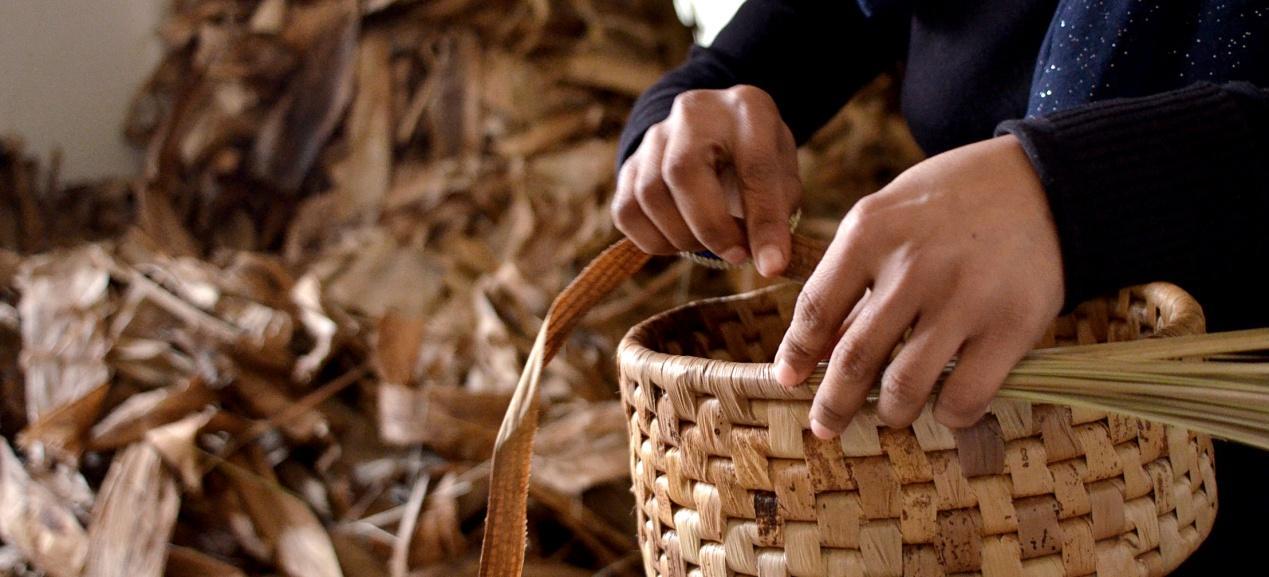Traditional Jordanian basketry is made from wheat straw and banana leaves. It is one one of the oldest weaving techniques and is passed down through generations. This basketry is particularly eco-friendly: it uses banana leaves that would be otherwise burnt after the harvesting season in the Jordan Valley.

Banana leaves basket on wheat straw plate, photo: Adeeb Atwan
Banana leaves are available throughout the year, by contrast to wheat straw which is only available in summer season. This issue allows the basket makers to continue producing, and selling, all over the year.
Basket making begins with selecting the appropriate banana leaves according to length and quality. They are manually cut, cleaned, dried and soaked in order to be soft and flexible to help manipulate in the weaving process.
The primary node is then built using simple hand tools as awl, pliers, sharp knife, scissors and large needle. This node underpins the whole basket due to its durability and consistency. Fibre is then inserted into this node by awl and bound leaves; the same process repeated several times. The object begins to spread in circular shape according to the design. Every three or four loops are followed by a node linked by the previous one until the project is completed.

Banana leaves basket making, source: Jordan River Foundation
Making each basket takes about a week depending on the size and time available for the craftspersons. They produce baskets and containers with multiple shapes, sizes and for many purposes.
Basketmaking requires skill, patience, accuracy and artistic vision. Banana leaf baskets are locally used as baskets for fruit, vegetables and as gift baskets. As decoration, they symbolize one of the unique features of Jordanian culture.
It is estimated that there are over 450 basket makers across Jordan. It mainly carried out by women and contributes to family income.
The two villages, Wadi Rayyan and Mkhaibeh, are closest to the banana farms in Jordan Valley. Inhabitants are well known for their talent in making baskets. As a natural product, hotels shops and factories have started to use these baskets as a packages for dates, dried fruits and Dead Sea beauty products. The multipurpose baskets are sold in different special craft stores in Jordan. They are also available at the Jordan River Foundation showrooms.
Mrs. Fairouz Ibdah is one of famous trainers in Wadi Rayyan village and Jordan Valley, and is also the manager of banana leaves basketry project founded by JRF in her area. Her depth of experience and extensive training has widely contributed to the success of basketmaking in Jordan .






My mother is a great weaver of wheat straw baskets – of course the natural ones. She grew up in Kufranjeh in north Jordan. At that time, the Jordan Valley was actually within the walking distance to the villagers who lived in Kufranjeh and the surrounding areas.
My mother’s decades old baskets are still used by us until this day. Their durability is amazing. I have been always fascinated with basketry, hence my mother taught me how to weave. The subject of basket weaving was of one of our favorite subjects, but what surprises me is that she never mentioned anything about baskets from banana leaves, given their proximity to the Jordan valley. I am wondering in which part of the Jordan valley banana basketry started, and in which form it was back in the old times.
Hello Maen,
Can you please share your contact. We are looking for people who can teach us how to make baskets commercially.